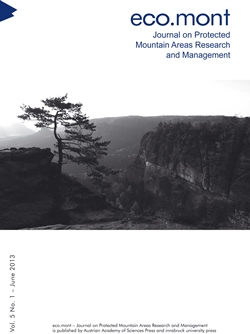
Eco.mont Vol. 5 Nr. 1, pp. 59-62, 2013/06/05
Journal on Protected Mountain Areas Research and Management

Anthropogenic climate change threatens the global environment, including biodiversity, and with it continued human welfare. TheEuropean Union aims to increase its share of renewable energy (RE) to 20% by 2020 in an effort to reduce greenhause gas emissionswhile enhancing energy security and providing opportunities for economic development. The Alpine region is expected tocontribute significantly to RE expansion. The trade-offs between potential gains and losses, especially for biodiversity, from new REdevelopments are rarely fully considered even though biodiversity loss has significant economic costs for society. The EU AlpineSpace recharge.green project develops tools to evaluate the RE carrying capacity of the biodiversity-rich Alpine ecosystems. The toolswill aid in the analysis of siting decisions and in weighing up costs and benefits to enable rational energy implementation decisions.The developed tools will be tested in five pilot regions in Austria, Germany, Italy, and Slovenia.